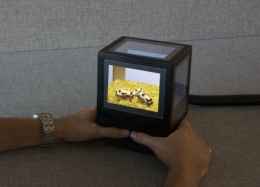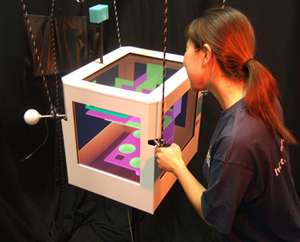March 31, 2010 report
3D without the glasses: introducing pCubee (w/ Video)

(PhysOrg.com) -- After a wave of 3D movies such as Alice in Wonderland and Avatar, and a number of television manufacturers producing 3D TVs this year, there is growing interest in a three-dimensional viewing experience. The usual 3D technology uses a stereoscopic principle in which a slightly different image is presented to each eye, thanks to the special glasses the viewer has to wear. Now a device named pCubee gives you the experience of 3D without the need for the glasses.
The pCubee consists of five LCD screens arranged as a cubic “fish tank” box that viewers can pick up, tilt, shake or turn to watch the 3D content or play games with virtual objects that seem to be within the box. Instead of stereoscopy, the device uses a principle called motion parallax, which is one of the means by which we usually perceive depth in a three dimensional scene. Motion parallax is a cue the brain is able to use to sense depth, because the movements of objects across our field of view depends on their relative distance from us. Having the box move means viewers do not need to move their heads to see the effect.
The five flat-panel LCD screens on the sides of the box are driven by three graphics pipelines. The perspective rendered on the screens is kept synchronized with the user’s view by a motion tracker that monitors both the user’s head and the pCubee box. That, and the real-time physics simulation engine, make the display look like a tank containing real objects. The box allows you to view a static 3D scene, or you can manipulate the box to navigate through the scene or play with objects colliding in the scene. You can also manipulate virtual objects using a stylus.
pCubee was developed at the Human Communication Technologies Laboratory at the University of British Columbia in Canada. Leader of the engineering team, Sidney Fels, said the group wanted to offer “a fish-tank-like experience” in a handheld device. Fels hopes the pCubee will be commercially available soon, but the researchers are continuing to refine the design, and may replace the current LCD panels with OLED screens. They are also building pCubees in different sizes for different applications.

The pCubee will have many more applications than 3D games, since it also has the potential to become a CAD-CAM platform, and could be used in museum displays. It was awarded Best Demonstration at the 2009 ACM International Conference on Multimedia in Beijing.
More information:
* UBC research page: hct.ece.ubc.ca/research/pcubee/
* pCubee site: www.cubee.ca/
© 2010 PhysOrg.com



















